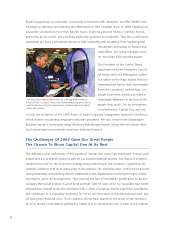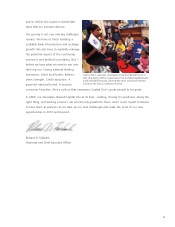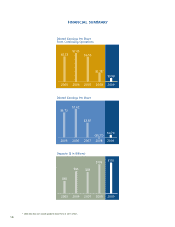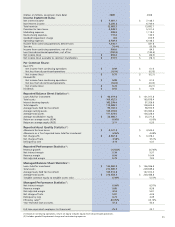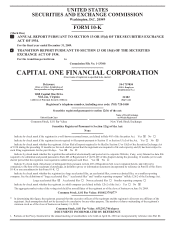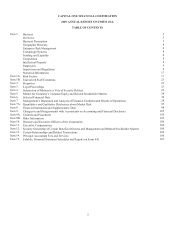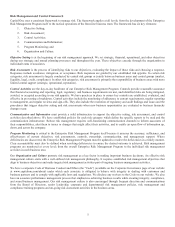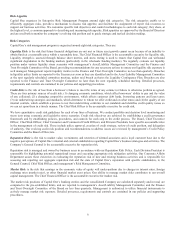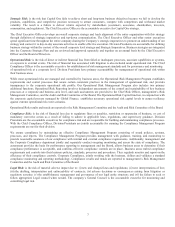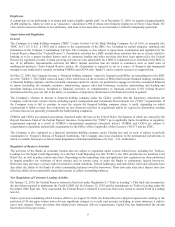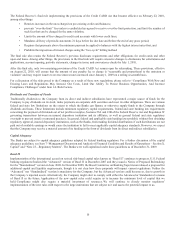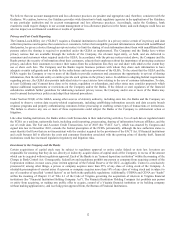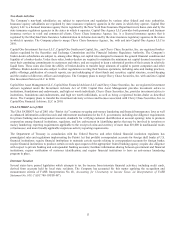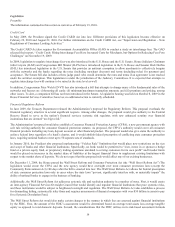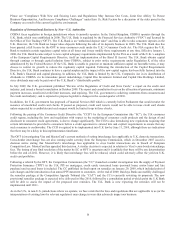Capital One 2009 Annual Report Download - page 19
Download and view the complete annual report
Please find page 19 of the 2009 Capital One annual report below. You can navigate through the pages in the report by either clicking on the pages listed below, or by using the keyword search tool below to find specific information within the annual report. 6
Risk Appetite
Capital One organizes its Enterprise Risk Management Program around eight risk categories. The risk categories enable us to
efficiently aggregate risks, provide a mechanism to discuss risk appetite, and facilitate the assignment of expert risk resources to
support our business activities. We customize specific risk objectives and control methodologies to each risk category; they share, at
the highest level, a common approach to describing and measuring risk appetite. Risk appetites are approved by the Board of Directors
and are used both to monitor the company’s evolving risk position and to guide strategic and tactical decision making.
Risk Categories
Capital One’s risk management program is organized around eight risk categories. They are:
Liquidity Risk: is the risk that future financial obligations are not met or future asset growth cannot occur because of an inability to
obtain funds at a reasonable price within a reasonable time. The Chief Financial Officer is the accountable executive for liquidity risk.
Liquidity strength is assessed through balance sheet metrics, and stress testing is used to ensure that Capital One can withstand
significant degradation in the funding markets (particularly in the wholesale funding markets). We regularly evaluate our liquidity
position under various liquidity stress scenarios with management’s Asset/Liability Management Committee and the Finance and
Trust Oversight Committee of the Board, providing recommendations for any necessary actions to ensure our liquidity risk exposure is
well managed. Management reports liquidity metrics to the Finance and Trust Oversight Committee no less than quarterly. Breaches
in liquidity policy limits are reported to the Treasurer as soon as they are identified and to the Asset/Liability Management Committee
at the next regularly scheduled committee meeting, unless said breach activates the Liquidity Contingency Plan. Breaches are also
reported to the Finance and Trust Oversight Committee no later than the next regularly scheduled meeting. Detailed processes,
requirements and controls are contained in our policies and supporting procedures.
Credit Risk: is the risk of loss from a borrower’s failure to meet the terms of any contract or failure to otherwise perform as agreed.
There are four primary sources of credit risk: (1) changing economic conditions, which affect borrowers’ ability to pay and the value
of any collateral; (2) a changing competitive environment, which affects customer debt loads, borrowing patterns and loan terms;
(3) our underwriting strategies and standards, which determine to whom we offer credit and on what terms; and (4) the quality of our
internal controls, which establish a process to test that underwriting conforms to our standards and identifies credit quality issues so
we can act upon them in a timely manner. The Chief Risk Officer is the accountable executive for credit risk.
We have quantitative credit risk guidelines for each of our lines of business. We conduct portfolio and decision level monitoring and
stress tests using economic and legislative stress scenarios. Credit risk objectives are achieved by establishing a credit governance
framework and by establishing policies, procedures, and controls for each step in the credit process. The Board, Chief Executive
Officer, Chief Risk Officer, Chief Consumer and Commercial Credit Officers, and Division Presidents have specific accountable roles
in the management of credit risk. These include policy approval, creation of credit strategy, review of credit position, and delegation
of authority. Our evolving credit risk position and recommendations to address issues are reviewed by management’s Credit Policy
Committee and the Board of Directors.
Reputation Risk: is the risk to market value, recruitment, and retention of talented associates and a loyal customer base due to the
negative perceptions of Capital One’s internal and external stakeholders regarding Capital One’s business strategies and activities. The
Company’s General Counsel is the accountable executive for reputation risk.
Reputation risk is managed and owned by business areas in accordance with our Reputation Risk Policy. Each Division President is
responsible for highlighting potential reputational issues and executing appropriate risk mitigation activities. Our Corporate Affairs
Department assists these executives in evaluating the reputation risk of new and existing business activities and is responsible for
assessing and reporting our aggregate reputation risk and the state of Capital One’s reputation with specific stakeholders, to the
General Counsel, Chief Risk Officer, and management’s Risk Management Committee.
Market Risk: is the risk that earnings or the economic value of equity will under-perform due to changes in interest rates, foreign
exchange rates (market rates), or other financial market asset prices. Our ability to manage market risks contributes to our overall
capital management. The Chief Financial Officer is the accountable executive for market risk.
The market risk positions of Capital One’s banking entities and the consolidated Company are calculated separately and in total, are
compared to the pre-established limits, and are reported to management’s Asset/Liability Management Committee and the Finance
and Trust Oversight Committee of the Board no less than quarterly. Management is authorized to utilize financial instruments to
actively manage market risk exposure. Detailed processes, requirements and controls are contained in our policies and supporting
procedures.


